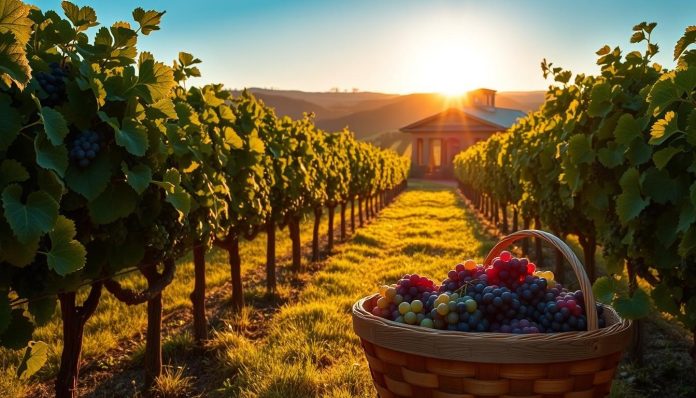Have you ever thought about how grapes become delicious late harvest wines?
Let’s dive into late harvest wines. Places like Bricoleur Vineyards turn grapes into celebrated wines. These wines are special because the grapes stay on the vine longer. This makes them sweeter and gives them a deep flavor.
Take Bricoleur Vineyards’ ‘The Last Note’ as an example. It’s a mix of Chardonnay and Viognier, picked at 30° Brix with 81 g/L sugar. This wine has aromas of honeysuckle and dried pineapple. It shows the skill needed to make such amazing wines.
If you love wine or just want to learn, late harvest wines offer an exciting adventure. You’ll see, smell, and taste the journey from grape to wine. This experience will make you love these sweet wines even more.
Introduction to Late Harvest Wines
Late harvest wines are known for their intense sweetness. This sweetness comes from grapes left to ripen longer than usual. It boosts their sugar, making these wines delightfully sweet and perfect for desserts. They’re the stars of prestigious grape-picking tours where you learn the secrets of making these wines.
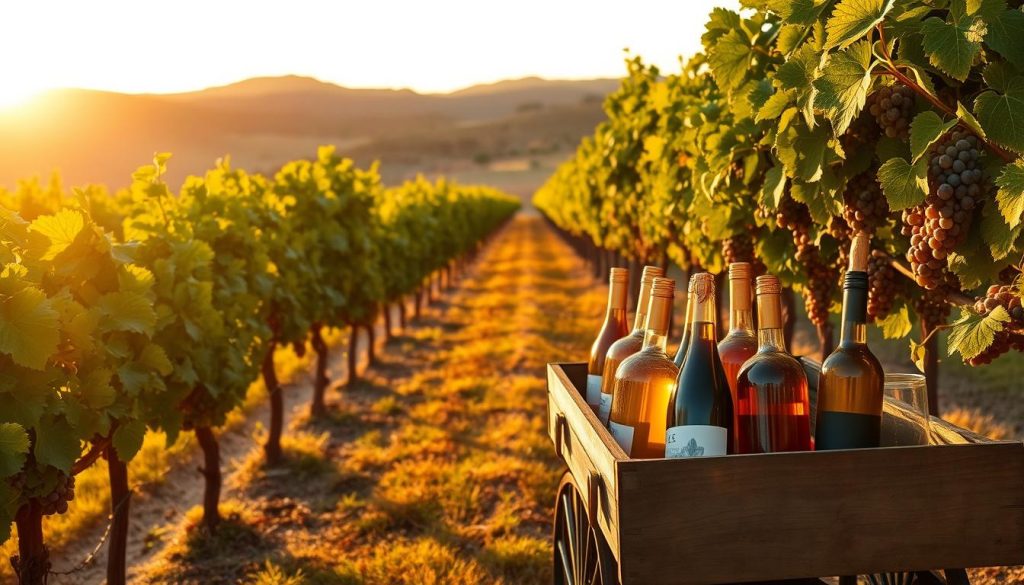
What Are Late Harvest Wines?
Late harvest wines are special because of how they’re made. Grapes for these wines stay on the vine longer, getting very sweet. Sometimes, a good type of fungus called noble rot makes them even sweeter. This makes the wines taste rich and like honey.
In the U.S., grape-picking starts in September or August in some places. Celebrating with vintage wines marks the beginning. These traditions and the wines capture the unique flavors of each season.
Grape Varieties for Late Harvest Wines
Certain grapes are perfect for late harvest wines because they get very sweet but stay fresh. Muscat, Gewürztraminer, Pinot Gris, and Riesling are some. These grapes do well in cool places and get left on the vine to overripen. A French term, vendange tardive, has been used since 1984 for such wines from famous regions.
Going on a grape-picking tour lets you see how these special wines are made. They have intense flavors and a beautiful golden color. You’ll see how different they are from regular wines. Visiting places like Bricoleur Vineyards shows why these sweet wines are so valued.
The Science Behind Late Harvest Wines
Late harvest wines are unique in the wine world. They offer intense flavors and sweetness. This comes from expert techniques and natural events. Learning about these processes lets you enjoy the complexity of these wines. It shows the adventure of making them.
Noble Rot and Its Role in Sweet Wines
Botrytis cinerea, or noble rot, is key in making sweet late harvest wines. This fungus dries grapes and concentrates their sugar. This is essential for the deep sweetness in wines like Sauternes. Such grapes give flavors of honey, orange marmalade, and caramel. They make the wine taste unique and unforgettable.
Grapes like Riesling are prone to botrytis cinerea. Misty mornings and dry afternoons are crucial for noble rot. This balance makes the grapes over-ripen perfectly. It produces famous wines from places like Bordeaux and Tokaji.
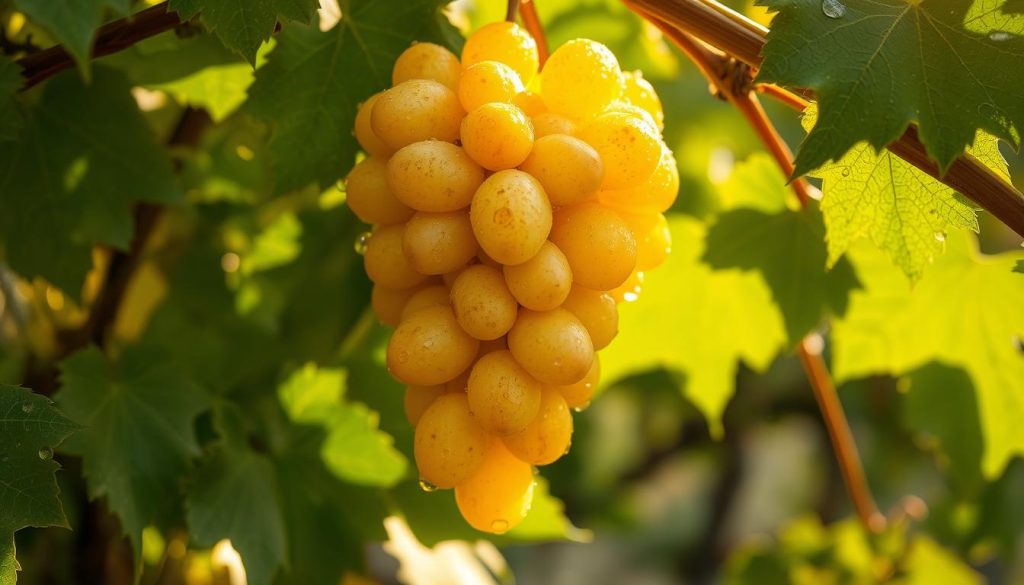
Harvesting Techniques
Gathering grapes for late harvest wines is both art and science. It is vital for keeping the grapes’ over-ripened traits and the wine’s low alcohol. These methods define the wine’s quality.
- On-the-vine drying: Grapes stay on the vine to dry naturally. This is key for making icewine in cold places like Niagara, Canada. There, grapes must freeze at -8°C (17.6°F) or colder.
- Off-the-vine drying: Workers hand-pick grapes. Then they spread them on straw or clay. This helps dry the grapes while keeping them high-quality.
At Bricoleur Vineyards, they blend these methods in their winemaking. They focus on hand-picking the best grapes. Their wine, ‘The Last Note,’ is famous for its tropical taste and sweetness.
| Technique | Description | Examples |
|---|---|---|
| On-the-Vine Drying | Grapes dry naturally on the vine, perfect for late harvest and ice wines. | Icewine (Canada), Noble Rot Wines (Bordeaux, Tokaji) |
| Off-the-Vine Drying | Grapes air dry on straw or clay, boosting flavors and concentration. | Straw Wine (Italy, South Africa) |
World-Class Vineyards for Late Harvest Experiences
Start your journey through top vineyards for late harvest in wine country. Visit the Russian River Valley’s Bricoleur Vineyards to see their dedication to making quality wine. You’ll dive deep into the winemaking culture.
In Sonoma County, California, over 130 wineries await. This makes the area a big player in American wine production. Visits offer not just tasting late harvest wines but also tours explaining how each bottle is made.
Upstate New York’s Finger Lakes area is home to famous wineries like Herman J. Wiemer Vineyards, Boundary Breaks Winery, and Sheldrake Point Winery. These places are experts in late harvest wines. They combine taste treats with gorgeous views.
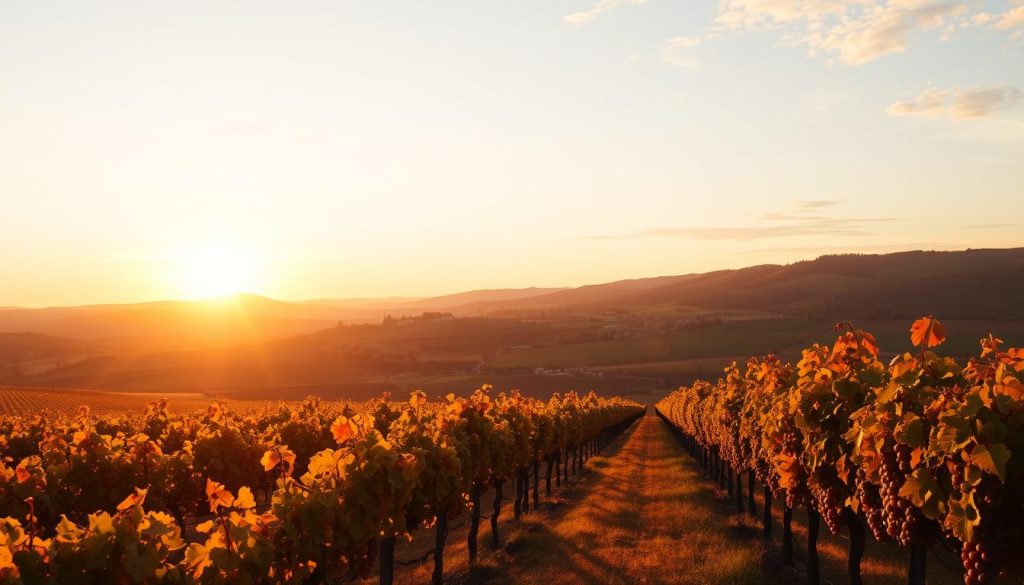
The Four Seasons Resort and Residences Napa Valley celebrates its second harvest. It has Forbes Travel Guide Five Stars and a Michelin star for its Auro restaurant. They offer a “Vine and Dine” package. It includes a luxurious stay, premium wine tasting, and a five-course meal with beautiful vineyard views.
The Finger Lakes shine with Hunt Country Vineyards and Wagner Vineyards. They’re known for their late harvest Vignoles and 2021 Riesling Ice Wine. At Elusa Winery events like Sunset Stroll and Harvest Happy Hour, learn more about wine. They feature partners such as Markham Vineyards.
If you’re after unique vineyard tours, try spa-inspired treatments at Spa Talisa. They use grape seeds and olive oil. This adds a special touch to your wine country visit, showing the beauty of vineyards during harvest.
Wine Harvest Experiences: Tours and Tastings
Dive into the world of wines with an enriching vineyard experience perfect for both experts and beginners. Enjoy grape picking and wine tasting, exploring how wine transforms from vine to bottle. It’s a journey filled with flavors and knowledge.
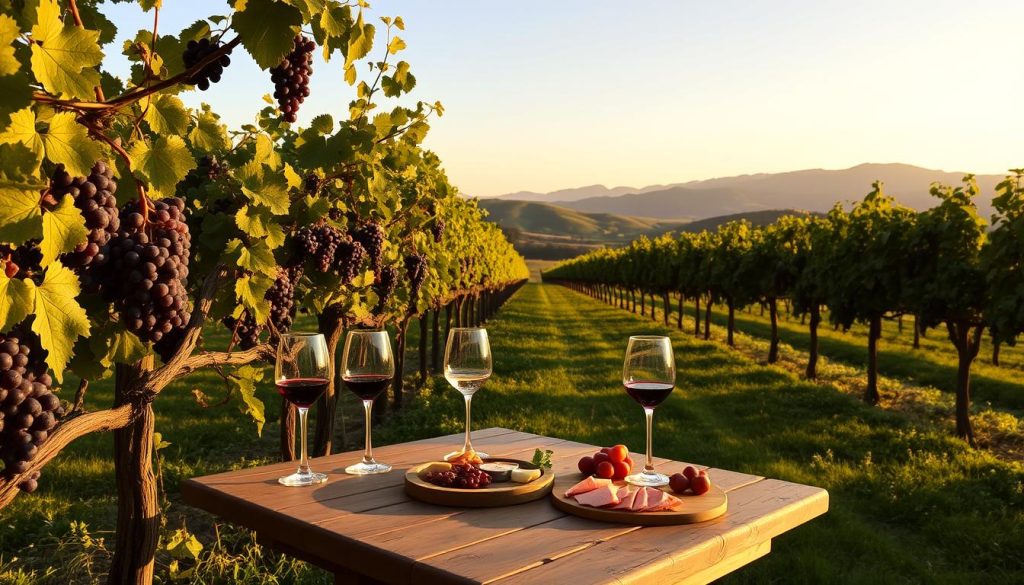
Grape Picking Tours
Join us at the Cuvaison Winery’s Harvest Event in Napa Valley on September 14, 2024. Tickets are $250. You can also go to Monte De Oro Winery’s Crush Event in Temecula on September 7, 2024, for $135. Or, get hands-on at Willamette Valley Vineyards on September 21-22, 2024, for just $30.
Wine Tasting Events
Upgrade your wine tour and tasting adventure with exciting events. The Bell Wine Cellars in Napa hosts a celebration on October 26, 2024, for $185. It comes with special tastings. Don’t miss Sonoma’s Harvest Fair on October 12, 2024, starting at $80. For something extra, the Healdsburg Plaza event on October 13 offers VIP tickets at $185.
Grape stomping fun is a must-do at harvest time. Enjoy the lively vibe and taste great wines. It’s a memorable way to experience the local culture and craft.
The Winemaking Adventure: From Grape to Glass
The journey from grape to glass reveals the complex winemaking process. This adventure takes us through many steps, each key to making top-quality wine. Steps like fermentation and oak aging shape the final taste.
Fermentation Process
Harvesting and crushing grapes starts the journey. Then, fermentation turns grape sugar into alcohol. This step changes based on the grape type. In places like Napa Valley, techniques vary to suit each grape. The choice of yeast, the control of temperature, and how long fermentation lasts are crucial.
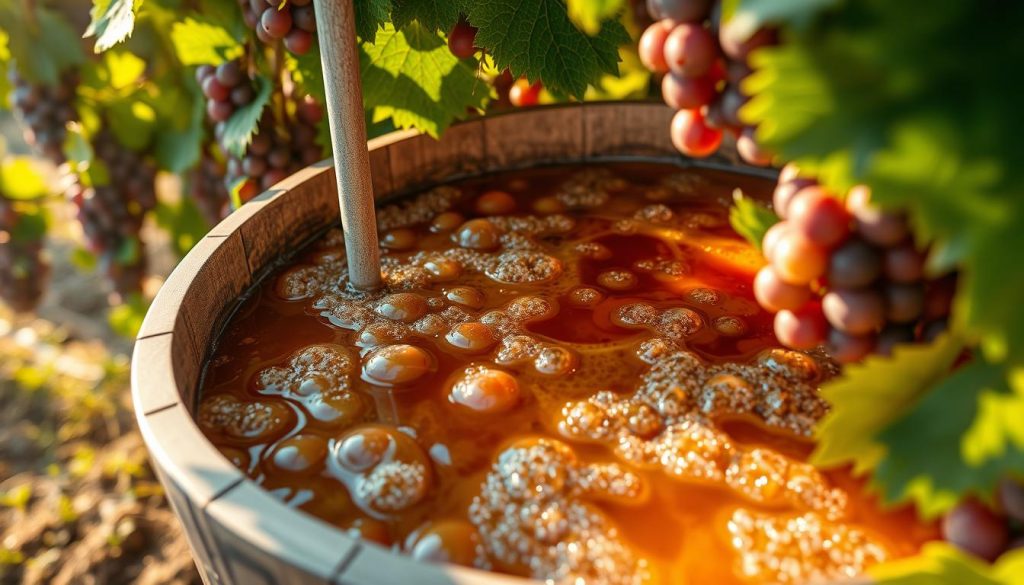
Winemaking experiences also include blending sessions. Wine lovers can make their own blend. They even get a bottle with their own label, creating a uniquely personal wine.
Aging and Bottling
The aging step is vital. Choosing between stainless steel and oak barrels affects the wine’s taste. Oak, for example, adds flavors like vanilla and spice. The type of barrel and how long the wine ages are important choices.
Barrel tasting tours let visitors taste wines as they age. This shows how oak, time, and blending decisions change the wine. It helps people appreciate the winemaker’s skill more deeply.
“The mediation between tradition and innovation in winemaking reveals itself through meticulous aging and bottling processes, ensuring that each bottle captures the essence of its origin.” — Expert Winemaker
Winemaking adventures can also include special events. For example, private dinners and harvest boot camps let people see how wine is made from start to finish. The Wine Camp at Trombetta Family Wines on September 28, 2024, costs $135 per person. A Small Vines Wines Private Tasting with a Winemaker is $100 per person for small groups, and $125 for larger ones. These events create a closer bond with the winemaking art.
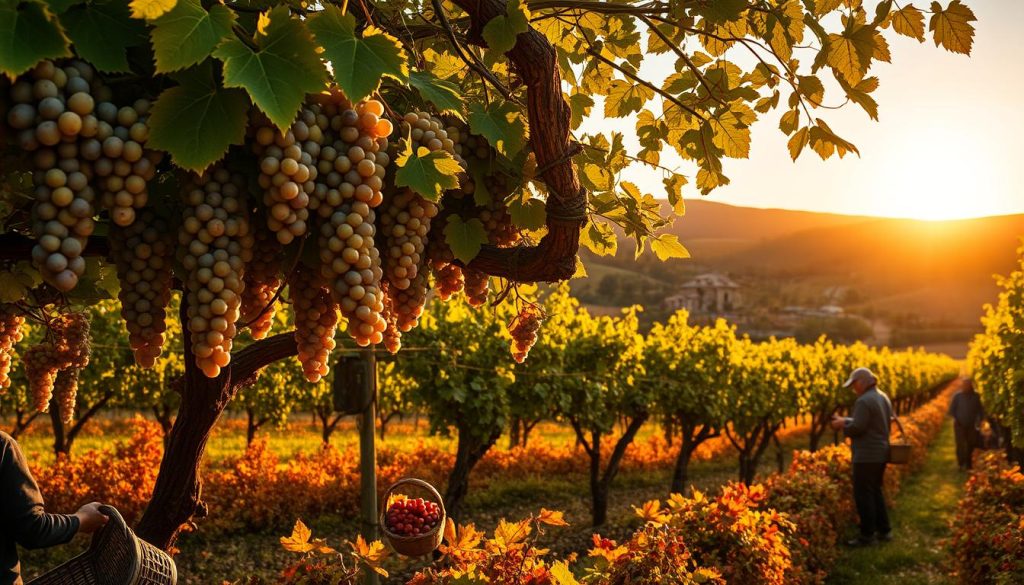
The complexity of aging and bottling is shown in vertical tastings. Here, different years of the same wine are compared. It shows how weather, vineyard conditions, and winemaking approaches affect the wine’s development, giving a full picture of its characteristics.
Unique Late Harvest Wines and Their Characteristics
Late harvest wines are celebrated as dessert wines with complex flavors. They are picked 1-2 months after the regular harvest. This lets the grapes develop a deep sweetness.
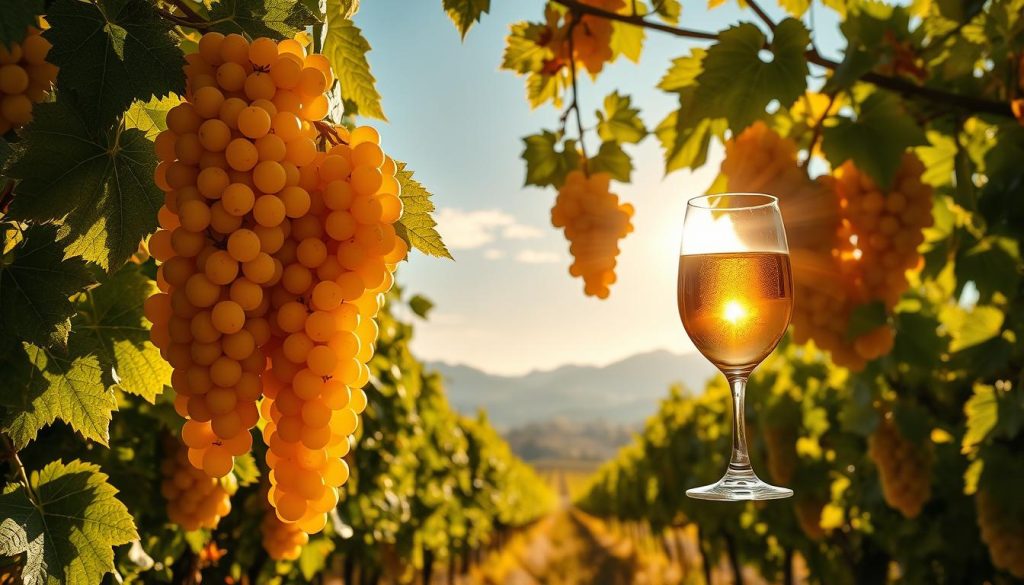
Riesling is an example that does well in cool places like Germany and Alsace. Its high acidity suits late harvest wines, making rich, honey-like tastes. The Sauternais blend, from Sauvignon Blanc and Sémillon, gets sweet from noble rot. This fungus makes the wine complex by focusing the sugar and flavors in the grapes.
Silvaner grape variety, one of the oldest, stands out in places like Orahovica. It makes wines with pear, apricot, and honey flavors, offering a unique profile. Meanwhile, Vidal Blanc grape is widely used for late harvest and ice wines in the United States and Canada.
Ice wine production is another fascinating technique. Grapes freeze on the vine before harvest. This makes very sweet wines that are balanced by acidity. This method is famous in Canada, New York, Germany, and Michigan. These wines, made traditionally or with new techniques, are meant to age and develop flavors over time.
The creation of late harvest wines includes stopping fermentation early to keep them sweet. Other dessert wines, like those from Muscat grapes, come in many flavors. They range from floral to fruity, fitting various styles worldwide.
Late harvest wines match well with many dishes, especially rich desserts. Their sweetness and tart, bold flavors pair nicely with cheese boards, savory foods, and fruit desserts.
In summary, late harvest wines show the artistry and patience of winemakers everywhere. From the effect of noble rot to choosing specific grapes like Silvaner and Riesling, they offer an unmatched tasting journey. Their flavors are intricate and complex.
The Cultural Significance of Late Harvest Wines
Late harvest wines are highly valued in wine culture. They show the complex art and effort put into making them. These wines are loved for their unique flavors and deep cultural history. This history is linked to traditions that go back hundreds of years.
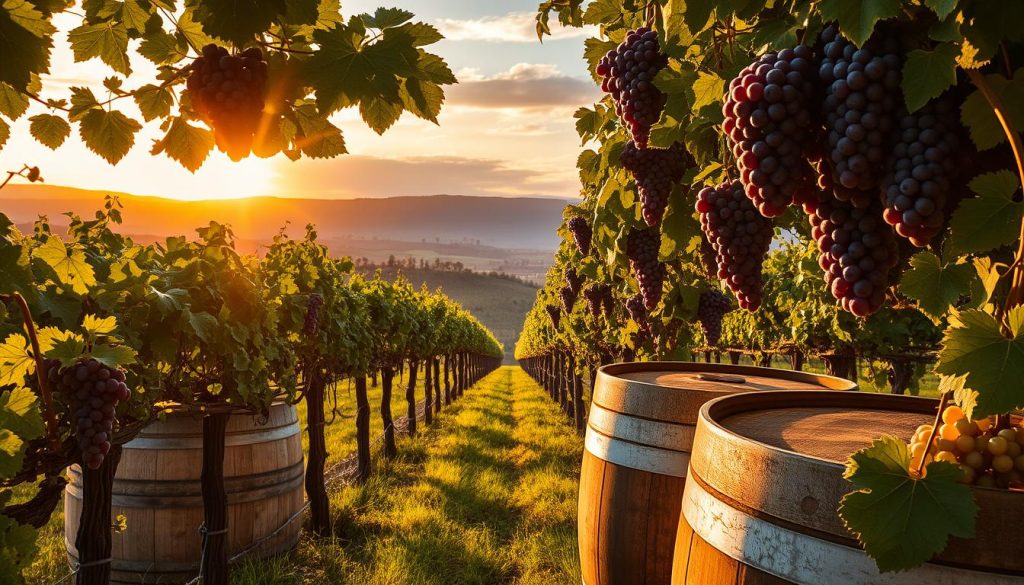
Historical Background
The story of late harvest wines is intriguing. It dates back to olden days when winemakers would leave grapes to ripen longer on the vine. This made the grapes sweeter. For example, Riesling from Germany makes a great late harvest wine. It’s known for its perfect mix of sweetness and acidity.
In Bordeaux, Sauternais wines are made mostly from Sauvignon Blanc and Sémillon grapes. They get their sweetness from noble rot, which enhances their sugars. It adds flavors of honey and fruits. In Italy, Vin Santo is made by drying grapes for sometimes up to four years. This makes the wine rich and sweet.
Modern-Day Celebrations
Nowadays, we still celebrate late harvest wines, honoring old traditions. Venues like Bricoleur Vineyards and Four Seasons Resort Napa Valley hold events. These include vineyard tours and grape picking. Plus, there are tastings of late harvest wines. This lets wine fans experience the whole process of winemaking.
Linganore Winecellars offers over 30 wine types, featuring late harvest ones. They use special selection and freezing techniques on Vidal Blanc grapes. This boosts the flavors and sugars. So, the wine is both rich and tasty.
In summary, loving late harvest wines is more than enjoying their taste. It connects us to wine history and wine culture. These wines link the past to the present. They give us a glimpse of our heritage with every sip.
Harvest Festival Activities
The essence of seasonal celebrations shines bright during the weekend of September 28 & 29, 2024. It’s all about lively harvest festival activities. These activities are designed to capture the season’s spirit.
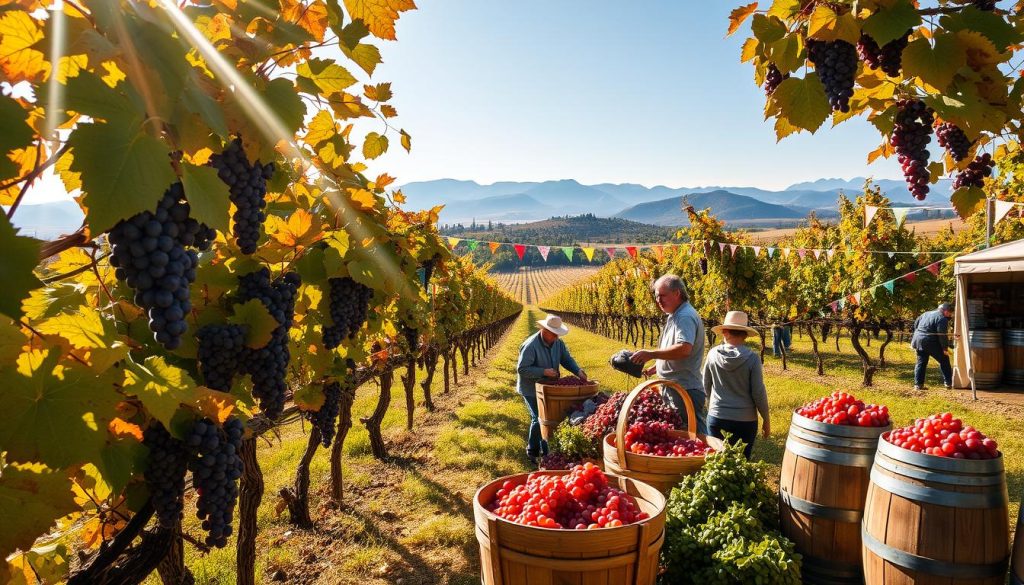
With a 2-DAY tasting pass, visitors get three wine tastes. They also enjoy food samples at each winery. Before Sept. 26, tickets are $30 online, then $35. Designated drivers get food samples for $20.
The event is from 12 pm to 5 pm. It features delicious foods like:
- Fall harvest chowder shooters
- Cheesecakes
- Ham and cheese sliders
- Pumpkin lentil soup
- Corn dip
- Pumpkin bisque
- Sugar and cinnamon hand-rolled donuts
- Chicken and broccoli (vegetarian option: broccoli and rice)
These festivals spotlight seasonal celebrations with wine activities. They deepen the connection to our wine heritage. Tickets are available at wineries, tax included. Groups of more than six should book in advance.
| Ticket Type | Price | Early Bird Price (ends Sept. 2) |
|---|---|---|
| General 2-Day | $75 | $65 |
| Saturday Only | $55 | $50 |
| Sunday Only | $45 | $40 |
| Designated Driver | $25 | N/A |
The Fair Play AVA event in Somerset, California, adds excitement. It’s set for November 2-3, 2024. From 11 am to 5 pm, 23 wineries offer tastings and tours for up to ten guests.
Visitors also enjoy U-Pick farms in places like Finger Lakes Wine Country. These offer fresh produce picking and buying. The area is known for its top-notch wines and local foods. These festivals are a must-do, come rain or shine. They are the best way to enjoy the season’s gifts.
Pairing Late Harvest Wines with Food
Late harvest wines are perfect for pairing with food. Their sweetness and complex flavors enhance many seasonal cuisine options. They make an excellent choice for culinary lovers.
Cheese Boards and Savory Dishes
Pairing these wines with cheese boards is a real treat. For example, Concha y Toro’s Late Harvest pairs well with blue cheese. It has the right acidity and body for umami-rich cheeses.
Also, foie gras goes great with late harvest wines. The wine’s flavors of papaya, Mediterranean fruits, and honey add a unique touch.
| Wine | Cheese | Additional Pairing Suggestions |
|---|---|---|
| Concha y Toro’s Late Harvest | Blue Cheese | Foie Gras, Mediterranean Fruits |
| Riesling Late Harvest | Aged Gouda | Garlic Shrimp, Asparagus |
| Chardonnay Late Harvest | Cheddar Cheese | Garlic Shrimp, Rice Pilaf |
Fruit-Based and Rich Desserts
These wines also shine with fruit-based and rich desserts. They balance the dish’s sweetness perfectly. A sweet late harvest rosé pairs well with poached rhubarb and vanilla ice cream.
Finger Lakes Late Harvest wines are great with desserts. They have noble rot and a wide range of residual sugar. They are perfect for pumpkin cheesecake, lemon cheesecake, or apple tart.
| Dessert | Wine Pairing | Additional Pairing Suggestions |
|---|---|---|
| Poached Rhubarb with Vanilla Ice Cream | Late Harvest Rosé | Riesling, Syrah |
| Carrot Cake with Goat Cheese Frosting | Sweet Late Harvest Wine | Hot Tea |
| Lemon Cheesecake | Chardonnay Late Harvest | Fresh Berries |
Late harvest wines are wonderful for food and wine pairings. They bring out the best in seasonal cuisine. Their sweet, nuanced profiles make them ideal for any occasion.
Vineyard Experiences Around the World
Embark on a journey through global wine tours. Explore what international vineyards offer. With more than 3500 wineries worldwide, there are over 6000 wine experiences to book. From budget-friendly tours to exclusive fine wine tastings, there’s a fit for all.
Visiting famous wine regions like Bordeaux, Tuscany, and California offers a special experience. Travelers often praise the great wine and hospitality they find. With a vast selection of wines—red, white, rosé, amber, sparkling, and fortified—every visit is unique.
| Wine Region | Experience Type | Price Range (€) |
|---|---|---|
| Burgundy | Wine Tasting | 18.00 |
| Châteauneuf-du-Pape | Intensive Fine Wine Experience | 450.00 |
| Spain | Wine Tours | 10.00 – 330.00 |
Specialized guides offer curated tours in Spain, New Zealand, Greece, and Australia. Wineries list on platforms for free, connecting with international travelers. This helps enthusiasts find hidden gems and unforgettable vineyard experiences.
The harvest season runs from August to October in the northern hemisphere. In the southern hemisphere, it’s February to April. These times offer grape picking, tours, stomping, tastings, and picnics. Experiences can last a few hours to days, diving deep into winemaking.
Harvest activities include tasting fresh grape juice and sampling wines. You’ll learn about terroirs and grape varieties. Events may have special meals like luncheons and picnics among the vines. These moments give an in-depth view of winemaking, linking tradition with the final product.
Why Late Harvest Wines Are Perfect for Your Collection
Adding late harvest wines to your collection brings unique benefits. Harvested in November or December, they have more sugar. This sugar makes them sweet and great for aging. These wines get complex flavors from staying on the vine longer. This makes them a great addition to any collection.
Aging Potential
Late harvest wines have amazing aging potential. Their high sugar acts as a natural preservative. Wines from places like Bricoleur Vineyards can age beautifully, getting more complex over time. They gain sophisticated flavors like honey, caramel, and dried fruit from Noble Rot. This aging process lets you enjoy their full flavor later.
Flavor Development Over Time
As they age, late harvest wines change flavors. They start sweet and fruity and gain deeper flavors like vanilla and nuts. This evolution makes each tasting unique and delightful. A wine like Douro’s Pacheca Colheita Tardia shows how aging improves wine. It highlights the balance between sweetness and acidity.
| Wine Feature | Young Late Harvest Wine | Aged Late Harvest Wine |
|---|---|---|
| Sugar Content | High | High |
| Flavor Profile | Fruity, Sweet | Honey, Caramel, Dried Fruits |
| Ideal Drinking Temperature | 10ºC to 12ºC | 10ºC to 12ºC |
These features make late harvest wines exciting for collectors. Adding them to your cellar enhances its diversity. You also ensure a future with interesting and rich tasting experiences.
Conclusion
Exploring late harvest wines uncovers a mix of nature, science, and tradition. We see the importance of noble rot and careful harvesting. These steps emphasize the skill needed to make these special wines. Places like Pennsylvania show how timing and weather affect winemaking.
Going to top vineyards lets us see late harvest wines’ background. Activities like grape-picking and tastings teach us about this wine aspect. They also offer fun like festivals, showing the wine’s versatility.
Late harvest wines are gems for enthusiasts and collectors. They get better with time and have rich flavors. Owning these wines means you have a piece of the vineyard’s hard work and history. As you enjoy these sweet wines, you’re enjoying more than a drink. You’re celebrating a craft steeped in tradition.

































